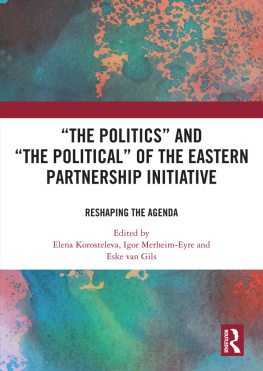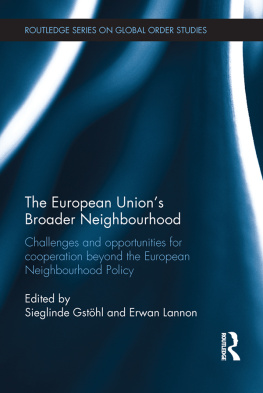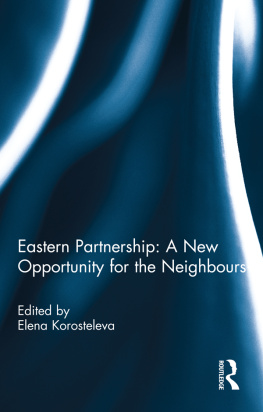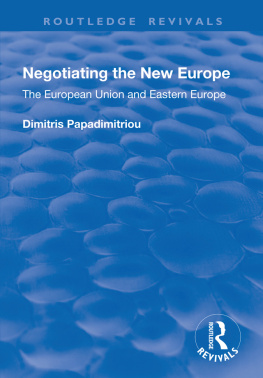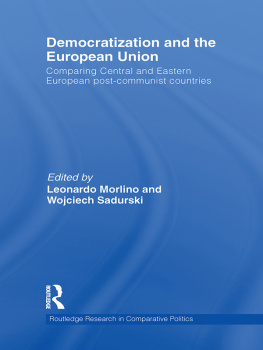The European Union and Its Eastern Neighbourhood
This edited volume brings together some of the most important scholarly perspectives in the form of both journal article reprints and original contributions on the structure and dynamics of the EUs multi-layered relations with its Eastern neighbours within the Eastern Partnership (EaP) framework and beyond.
In May 2019, the EUs EaP an ambitious and sophisticated policy framework, conjoining elements of cooperation and integration, with the EUs six Eastern neighbours, i.e. Ukraine, Belarus, Moldova, Georgia, Armenia and Azerbaijan turned ten years. This anniversary, in conjunction with repeatedly voiced critique by scholars and policy-makers alike regarding the frameworks effectiveness and utility, led the EU to submit the EaP to a fundamental auditing and revision.
Structured around both enduring and emerging issues in the broader EU-Eastern neighbourhood framework, this book provides a retrospective analysis of key structural and relational challenges, unfolding regional dynamics, distinctive forms of bilateral/multilateral engagement, whilst also offering a critical perspective on the contested future relations between the EU and its Eastern neighbours. Looking backwards and providing a critical and thorough assessment of the first ten years of the EaP in practice, this book thinks forward and gauges its many potential future avenues. This comes at a crucial moment, as the EU and its six Eastern neighbours are in search of new and mutually acceptable forms of association.
Andriy Tyushka is Senior Research Fellow in the European Neighbourhood Policy Chair at the College of Europe in Natolin, Poland. He published widely on IR theory, European security and EU foreign policy. His latest book publication is the co-edited volume States, International Organizations and Strategic Partnerships (2019).
Tobias Schumacher is Professor of International Relations and Chairholder of the European Neighbourhood Policy Chair at the College of Europe, Natolin campus (Warsaw) and Associate Professor in European Studies at the Department of Historical and Classical Studies (IHK) at the Norwegian University of Science and Technology (NTNU), Trondheim. He is the lead editor of The Routledge Handbook on the European Neighbourhood Policy (2018), and his articles have appeared in journals such as Journal of Common Market Studies, Geopolitics, Democratization, Mediterranean Politics, European Security, Contemporary Politics, Global Discourse and others.
First published 2022
by Routledge
2 Park Square, Milton Park, Abingdon, Oxon, OX14 4RN
and by Routledge
605 Third Avenue, New York, NY 10158
Routledge is an imprint of the Taylor & Francis Group, an informa business
Introduction 2022 Tobias Schumacher
2022 University of Glasgow
2022 Taylor & Francis
Chapter 5 2022 Istituto Affari Internazionali
Chapter 8 2022 European International Studies Association
Chapter 13 2022 Andriy Tyushka and Tobias Schumacher
Conclusion 2022 Andriy Tyushka
All rights reserved. No part of this book may be reprinted or reproduced or utilised in any form or by any electronic, mechanical, or other means, now known or hereafter invented, including photocopying and recording, or in any information storage or retrieval system, without permission in writing from the publishers.
Trademark notice: Product or corporate names may be trademarks or registered trademarks, and are used only for identification and explanation without intent to infringe.
British Library Cataloguing in Publication Data
A catalogue record for this book is available from the British Library
ISBN: 978-0-367-53895-8 (hbk)
ISBN: 978-0-367-53898-9 (pbk)
ISBN: 978-1-003-08363-4 (ebk)
DOI: 10.4324/9781003083634
Typeset in Bembo
by codeMantra
Publishers Note
The publisher accepts responsibility for any inconsistencies that may have arisen during the conversion of this book from journal articles to book chapters, namely the inclusion of journal terminology.
Disclaimer
Every effort has been made to contact copyright holders for their permission to reprint material in this book. The publishers would be grateful to hear from any copyright holder who is not here acknowledged and will undertake to rectify any errors or omissions in future editions of this book.
Tables, chart and figures
Tables
3.1 Consistency and effectiveness of democratic conditionality
3.2 The groups of ENP states
13.1 Interlocking dimensions of EU-Eastern neighbours relations (20092019)
13.2 20 Deliverables for 2020: Monitoring and implementation progress (February 2020)
Chart
I.1 The structure of the EaP framework
Figures
3.1 Decision tree for EU consistency and effectiveness in the ENP countries
5.1 Summary of the unintended consequences model and its application to the case of EU decoupling of its East European policies
13.1 (a&b). The state of EU-EaP countries linkage and approximation in 20112017
Citation information
The in this book were originally published between 2015 and 2020 in the following journals: Democratization, East European Politics, Eurasian Geography and Economics, Europe-Asia Studies, European Politics and Society, Geopolitics, Global Affairs, Problems of Post-Communism and The International Spectator: Italian Journal of International Affairs. When citing this material, please use the original page numbering for each article, as follows:
Nitoiu, C. (2018). The European Unions Ideal Self in the Post-Soviet Space. Europe-Asia Studies, 70(5), 692710.
Chapter 2
Delcour L. (2015). Between the Eastern Partnership and Eurasian Integration: Explaining Post-Soviet Countries Engagement in (Competing) Region-Building Projects. Problems of Post-Communism, 62(6), 316327.
Chapter 3
Brzel, T. A., & Lebanidze, B. (2017). The transformative power of Europe beyond enlargement: the EUs performance in promoting democracy in its neighbourhood. East European Politics, 33(1), 1735.
Chapter 4
Cadier, D. (2019). The Geopoliticisation of the EUs Eastern Partnership. Geopolitics, 24(1), 7199.
Chapter 5
Casier, T. (2019). The Unintended Consequences of a European Neighbourhood Policy without Russia. The International Spectator, 54(1), 7688.
Chapter 6
Simo, L. (2017). Bringing the political back into European security: challenges to the EUs ordering of the Eastern Partnership. East European Politics, 33(3), 338354.
Chapter 7
Wolczuk, K. (2019). State Building and European Integration in Ukraine. Eurasian Geography and Economics, 60(6), 736754.
Chapter 8
Nizhnikau, R. (2016). When Goliath meets Goliath: how Russia and the EU created a vicious circle of instability in Moldova. Global Affairs, 2(2), 203216.
Chapter 9
Dobrescu, M., & Schumacher, T. (2020). The Politics of Flexibility: Exploring the Contested StatehoodEU Actorness Nexus in Georgia. Geopolitics, 25(2), 407427.
Chapter 10
Vieira, A., & Vasilyan, S. (2018). Armenia and Belarus: Caught between the EUs and Russias conditionalities? European Politics and Society, 19(4), 471489.
Chapter 11
Korosteleva, E. (2016). The European Union and Belarus: democracy promotion by technocratic means?



